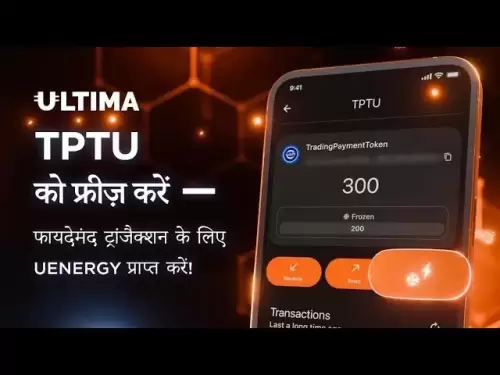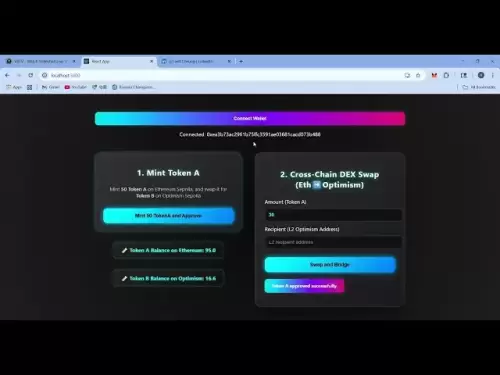-
 Bitcoin
Bitcoin $109,459.7682
2.44% -
 Ethereum
Ethereum $2,598.6052
6.29% -
 Tether USDt
Tether USDt $1.0003
0.00% -
 XRP
XRP $2.2734
3.95% -
 BNB
BNB $661.4886
1.58% -
 Solana
Solana $155.4825
4.35% -
 USDC
USDC $0.9999
-0.02% -
 TRON
TRON $0.2838
1.04% -
 Dogecoin
Dogecoin $0.1740
8.25% -
 Cardano
Cardano $0.6047
9.04% -
 Hyperliquid
Hyperliquid $40.2302
6.50% -
 Sui
Sui $2.9863
10.05% -
 Bitcoin Cash
Bitcoin Cash $509.5786
0.60% -
 Chainlink
Chainlink $13.8156
6.03% -
 UNUS SED LEO
UNUS SED LEO $9.0142
0.69% -
 Avalanche
Avalanche $19.0337
8.68% -
 Stellar
Stellar $0.2438
5.17% -
 Toncoin
Toncoin $2.9012
3.59% -
 Shiba Inu
Shiba Inu $0.0...01210
6.20% -
 Litecoin
Litecoin $90.0882
7.05% -
 Hedera
Hedera $0.1597
8.53% -
 Monero
Monero $326.3340
2.88% -
 Polkadot
Polkadot $3.6365
9.32% -
 Bitget Token
Bitget Token $4.6162
2.72% -
 Dai
Dai $1.0001
0.00% -
 Ethena USDe
Ethena USDe $1.0002
-0.01% -
 Uniswap
Uniswap $7.6403
10.47% -
 Pepe
Pepe $0.0...01060
12.03% -
 Aave
Aave $281.3664
7.56% -
 Pi
Pi $0.4992
1.76%
Notes on leveraged trading on OKX
Leveraged trading on OKX offers increased potential profits and flexibility but requires careful management to avoid significant losses.
Nov 19, 2024 at 08:44 pm

Notes on Leveraged Trading on OKX
Introduction
Leveraged trading is a powerful tool that can amplify both profits and losses. It allows traders to increase their exposure to an asset without tying up as much capital. However, it is important to use leverage carefully, as it can also lead to significant losses.
Understanding Leverage
Leverage is expressed as a ratio, such as 10x, 20x, or 50x. This ratio indicates the amount of capital that the trader is borrowing from the exchange. For example, if a trader has $1,000 and uses 10x leverage, they will be able to trade with $10,000.
Benefits of Leveraged Trading
- Increased potential profits: Leverage can amplify profits, as it allows traders to control a larger position with less capital.
- Flexibility: Leverage can be used to trade both long and short positions, allowing traders to profit from both rising and falling markets.
- Margin efficiency: Leverage can help traders to make more efficient use of their margin.
Risks of Leveraged Trading
- Increased potential losses: Leverage can also amplify losses, as it increases the amount of capital that is at risk.
- Margin calls: If the value of the trader's position falls below a certain level, the exchange may issue a margin call, requiring the trader to deposit additional funds or close their position.
- Liquidation: If the trader is unable to meet a margin call, their position will be liquidated, resulting in the loss of their entire investment.
Steps for Leveraged Trading on OKX
- Create an account on OKX: To start leveraged trading on OKX, you will need to create an account.
- Fund your account: Once you have created an account, you will need to fund it with the cryptocurrency that you want to trade.
- Choose a trading pair: Leveraged trading is only available for certain trading pairs on OKX. You can view the list of available trading pairs on the exchange's website.
- Set your leverage: Once you have chosen a trading pair, you will need to set your leverage ratio. You can choose from a variety of leverage ratios, depending on your risk tolerance.
- Place your order: Once you have set your leverage, you can place your order. You can choose from a variety of order types, such as market orders, limit orders, and stop orders.
- Monitor your position: Once you have placed your order, you should monitor your position closely. You should be aware of the risks involved in leveraged trading and be prepared to take appropriate action if the value of your position moves against you.
Conclusion
Leveraged trading can be a powerful tool that can help traders to increase their profits. However, it is important to use leverage carefully, as it can also lead to significant losses. Traders should be aware of the risks involved in leveraged trading and should only use it with capital that they can afford to lose.
Disclaimer:info@kdj.com
The information provided is not trading advice. kdj.com does not assume any responsibility for any investments made based on the information provided in this article. Cryptocurrencies are highly volatile and it is highly recommended that you invest with caution after thorough research!
If you believe that the content used on this website infringes your copyright, please contact us immediately (info@kdj.com) and we will delete it promptly.
- Coinbase's Crypto Conquest: The Liquifi Acquisition and the Token Revolution
- 2025-07-03 16:30:12
- Neo Pepe Coin: Can This Meme Coin Make Waves in the 2025 Crypto Market?
- 2025-07-03 16:50:12
- Toncoin, Dogecoin, and Shiba Inu: A Wild Ride in the Crypto Zoo
- 2025-07-03 16:30:12
- AllScale: Stablecoin Solutions Empowering Small Businesses – A New York Perspective
- 2025-07-03 16:35:12
- Neo Pepe Coin Presale: Is This Meme Coin a Serious Crypto Investment?
- 2025-07-03 17:10:11
- Memecoins to Buy in July 2025: Riding the Hype or Investing Wisely?
- 2025-07-03 17:10:11
Related knowledge

How to identify the contract value range in combination with the market profile?
Jul 02,2025 at 10:56pm
Understanding the Market ProfileTo effectively identify the contract value range in combination with the market profile, it's essential to first understand what each concept entails. The market profile is a framework that helps traders visualize how price and time interact across a given period, typically a trading day or session. It provides insights i...

How to use the price slope to filter the false breakthrough signal of the contract?
Jun 20,2025 at 06:56pm
Understanding the Concept of Price Slope in Contract TradingIn contract trading, especially within cryptocurrency derivatives markets, price slope refers to the rate at which the price changes over a specific time period. It helps traders assess the strength and sustainability of a trend. A steep slope may indicate strong momentum, while a shallow slope...

How to determine the expected volatility of the contract through the volatility cone?
Jun 19,2025 at 12:28pm
Understanding the Basics of Volatility in Cryptocurrency ContractsIn the realm of cryptocurrency trading, volatility is a key metric that traders use to assess potential risk and reward. When dealing with futures contracts, understanding how volatile an asset might become over time is crucial for position sizing, risk management, and strategy developmen...

How to formulate a contract intraday trading plan in combination with the pivot point system?
Jun 21,2025 at 03:42pm
Understanding the Basics of Pivot Points in Cryptocurrency TradingPivot points are technical analysis tools used by traders to identify potential support and resistance levels. These levels are calculated using the previous day's high, low, and closing prices. In the context of cryptocurrency trading, where markets operate 24/7, pivot points help trader...

How to adjust the contract position ratio through the price fluctuation entropy?
Jun 22,2025 at 11:42am
Understanding Price Fluctuation Entropy in Cryptocurrency ContractsIn the world of cryptocurrency futures trading, price fluctuation entropy is a relatively new concept used to measure market volatility and uncertainty. It derives from information theory, where entropy refers to the degree of randomness or unpredictability in a system. In crypto contrac...

How to use the volume swing indicator to predict the contract volume-price divergence?
Jun 18,2025 at 11:42pm
Understanding the Volume Swing IndicatorThe volume swing indicator is a technical analysis tool used primarily in cryptocurrency trading to evaluate changes in volume over time. Unlike price-based indicators, this metric focuses solely on trading volume, which can provide early signals about potential market reversals or continuations. The key idea behi...

How to identify the contract value range in combination with the market profile?
Jul 02,2025 at 10:56pm
Understanding the Market ProfileTo effectively identify the contract value range in combination with the market profile, it's essential to first understand what each concept entails. The market profile is a framework that helps traders visualize how price and time interact across a given period, typically a trading day or session. It provides insights i...

How to use the price slope to filter the false breakthrough signal of the contract?
Jun 20,2025 at 06:56pm
Understanding the Concept of Price Slope in Contract TradingIn contract trading, especially within cryptocurrency derivatives markets, price slope refers to the rate at which the price changes over a specific time period. It helps traders assess the strength and sustainability of a trend. A steep slope may indicate strong momentum, while a shallow slope...

How to determine the expected volatility of the contract through the volatility cone?
Jun 19,2025 at 12:28pm
Understanding the Basics of Volatility in Cryptocurrency ContractsIn the realm of cryptocurrency trading, volatility is a key metric that traders use to assess potential risk and reward. When dealing with futures contracts, understanding how volatile an asset might become over time is crucial for position sizing, risk management, and strategy developmen...

How to formulate a contract intraday trading plan in combination with the pivot point system?
Jun 21,2025 at 03:42pm
Understanding the Basics of Pivot Points in Cryptocurrency TradingPivot points are technical analysis tools used by traders to identify potential support and resistance levels. These levels are calculated using the previous day's high, low, and closing prices. In the context of cryptocurrency trading, where markets operate 24/7, pivot points help trader...

How to adjust the contract position ratio through the price fluctuation entropy?
Jun 22,2025 at 11:42am
Understanding Price Fluctuation Entropy in Cryptocurrency ContractsIn the world of cryptocurrency futures trading, price fluctuation entropy is a relatively new concept used to measure market volatility and uncertainty. It derives from information theory, where entropy refers to the degree of randomness or unpredictability in a system. In crypto contrac...

How to use the volume swing indicator to predict the contract volume-price divergence?
Jun 18,2025 at 11:42pm
Understanding the Volume Swing IndicatorThe volume swing indicator is a technical analysis tool used primarily in cryptocurrency trading to evaluate changes in volume over time. Unlike price-based indicators, this metric focuses solely on trading volume, which can provide early signals about potential market reversals or continuations. The key idea behi...
See all articles

























































































